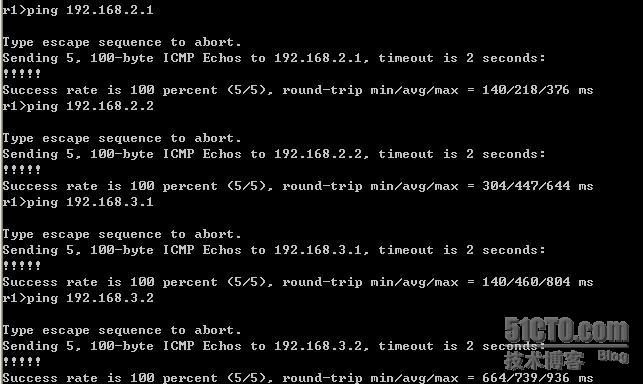静态路由的应用场合
• 一个小型到中型的网络,而且没有或只有较小的扩充计划时。
• 静态路由要手工输入,手工管理;管理开销对于动态路由来说是一个大大的负担。
静态路由优缺点
• 优点:
• 1.对路由器CPU没有管理性开销
• 2.在路由器间没有带宽占用
• 3.增加安全性
• 缺点:
• 1.必须真正了解网络
• 2.对于新添网络配置繁琐
• 3.对于大型网络工作量巨大
静态路由的配置
Router(config)#ip route network [mask] { address | interface}[distance] [permanent]
即Router(config)#ip route 目标网段 目标网段的网络掩码 直连邻居的接口IP地址
(直连邻居的接口IP地址=下一跳的IP地址=网关)
下面我们通过试验来验证静态路由的配置
CCNA试验我使用的是模拟器

试验环境如下:

试验环境说明:
R1的ip地址为 192.168.1.1(S0/0) 网络掩码为255.255.255.0
R2的ip地址为 192.168.1.2(S0/0) 192.168.2.1(S0/1) 网络掩码为255.255.255.0
R3的ip地址为 192.168.2.2 (S0/1) 192.168.3.1S0/2) 网络掩码为255.255.255.0
R4的ip地址为 192.168.3.2(S0/2) 网络掩码为255.255.255.0
R1的S0/0端口、R2的S0/1端口、R3的S0/2端口为DCE端
试验要求:
要求在路由器间配置静态路由使路由器间相互ping通。实现全网全通。
好了,开始工作
R1
en
conf t
host r1 定义路由器名称

enable password cisco 定义特权口令

line vty 0 4 定义telne口令
pass cisco
login

exit
int s0/0 定义接口信息
ip addr 192.168.1.1 255.255.255.0
clock rate 64000 设置时钟频率
no shut

exit
ip route 192.168.2.0 255.255.255.0 192.168.1.2 在R1中配置静态路由
ip route 192.168.3.0 255.255.255.0 192.168.1.2

R2
en
conf t
host r2 定义路由器名称

enable password cisco 定义特权口令

line vty 0 4 定义telne口令
pass cisco
login

exit
int s0/0 定义接口信息
ip addr 192.168.1.2 255.255.255.0
no shut
exit
int s0/1
ip addr 192.168.2.1 255.255.255.0
clock rate 64000 设置时钟频率
no shut

exit
ip route 192.168.3.0 255.255.255.0 192.168.2.2 在R2中配置静态路由

R3
en
conf t
host r3 定义路由器名称

enable password cisco 定义特权口令

line vty 0 4 定义telne口令
pass cisco
login

exit
int s0/1 定义接口信息
ip addr 192.168.2.2 255.255.255.0
no shut
exit
int s0/2
ip addr 192.168.3.1 255.255.255.0
clock rate 64000 设置时钟频率
no shut

exit
ip route 192.168.1.0 255.255.255.0 192.168.2.1 在R3中配置静态路由

R4
en
conf t
host r4 定义路由器名称

enable password cisco 定义特权口令

line vty 0 4 定义telne口令
pass cisco
login

exit
int s0/2 定义接口信息
ip addr 192.168.3.2 255.255.255.0
no shut

exit
ip route 192.168.1.0 255.255.255.0 192.168.3.1 在R3中配置静态路由
ip route 192.168.2.0 255.255.255.0 192.168.3.1

在R1上ping R2 R3 R4 如下图所示,全网全通啦

如下是在路由器R1 R2 R3 R4 里做出的配置 红色字体为配置内容
R1
Router>en
Router#conf t
Enter configuration commands, .e per line. End with CNTL/Z.
Router(config)#host r1
r1(config)#enable password cisco
r1(config)#line vty 0 4
r1(config-line)#pass cisco
r1(config-line)#login
r1(config-line)#exit
r1(config)#int s0/0
r1(config-if)#ip addr 192.168.1.1 255.255.255.0
r1(config-if)#clock rate 64000
r1(config-if)#no shut
r1(config-if)#exit
*Mar 1 00:05:14.311: %LINK-3-UPDOWN: Interface Serial0/0, changed state to up
*Mar 1 00:05:15.311: %LINEPROTO-5-UPDOWN: Line protocol . Interface Serial0/0,
changed state to up
r1(config)#ip route 192.168.2.0 255.255.255.0 192.168.1.2
r1(config)#
*Mar 1 00:05:43.055: %LINEPROTO-5-UPDOWN: Line protocol . Interface Serial0/0,
changed state to down
r1(config)#ip route 192.168.3.0 255.255.255.0 192.168.1.2
R2
Router>en
Router#conf t
Enter configuration commands, .e per line. End with CNTL/Z.
Router(config)#host r2
r2(config)#enable password cisco
r2(config)#line vty 0 4
r2(config-line)#pass cisco
r2(config-line)#login
r2(config-line)#exit
r2(config)#int s0/0
r2(config-if)#ip addr 192.168.1.2 255.255.255.0
r2(config-if)#no shut
r2(config-if)#
*Mar 1 00:05:21.035: %LINK-3-UPDOWN: Interface Serial0/0, changed state to up
*Mar 1 00:05:22.035: %LINEPROTO-5-UPDOWN: Line protocol . Interface Serial0/0,
changed state to upexit
r2(config)#int s0/1
r2(config-if)#ip addr 192.168.2.1 255.255.255.0
r2(config-if)#clock rate 64000
r2(config-if)#no shut
r2(config-if)#exit
r2(config)#
*Mar 1 00:25:35.283: %LINEPROTO-5-UPDOWN: Line protocol . Interface Serial0/1,
changed state to down%LINEPROTO-5-UPDOWN: Line protocol . Interface Serial0/1,
*Mar 1 00:25:45.267: %LINEPROTO-5-UPDOWN: Line protocol . Interface Serial0/1,
changed state to up: %LINEPROTO-5-UPDOWN: Line protocol . Interface Serial0/1,
changed state to down
r2(config)#ip route 192.168.3.0 255.255.255.0 192.168.2.2
R3
Router>en
Router#conf t
Enter configuration commands, .e per line. End with CNTL/Z.
Router(config)#host r3
r3(config)#enable password cisco
r3(config)#line vty 0 4
r3(config-line)#password cisco
r3(config-line)#login
r3(config-line)#exit
r3(config)#int s0/1
r3(config-if)#ip addr 192.168.2.2 255.255.255.0
r3(config-if)#no shut
r3(config-if)#exit
r3(config)#
*Mar 1 00:03:39.899: %LINK-3-UPDOWN: Interface Serial0/1, changed state to upi
*Mar 1 00:03:40.903: %LINEPROTO-5-UPDOWN: Line protocol . Interface Serial0/1,
changed state to u
r3(config)#int s0/2
r3(config-if)#ip addr 192.168.3.1 255.255.255.0
r3(config-if)#clock rate 64000
r3(config-if)#no shut
r3(config-if)#
*Mar 1 00:04:24.839: %LINK-3-UPDOWN: Interface Serial0/2, changed state to up
*Mar 1 00:04:25.839: %LINEPROTO-5-UPDOWN: Line protocol . Interface Serial0/2,
changed state to up
*Mar 1 00:04:53.839: %LINEPROTO-5-UPDOWN: Line protocol . Interface Serial0/2,
changed state to down
r3(config-if)#exit
r3(config)#ip route 192.168.1.0 255.255.255.0 192.168.2.1
.
R4
Router>en
Router#conf t
Enter configuration commands, .e per line. End with CNTL/Z.
Router(config)#host r4
r4(config)#enable pass cisco
r4(config)#line vty 0 4
r4(config-line)#pass cisco
r4(config-line)#login
r4(config-line)#exit
r4(config)#int s0/2
r4(config-if)#ip addr 192.168.3.2 255.255.255.0
r4(config-if)#no shut
r4(config-if)#
*Mar 1 00:03:04.871: %LINK-3-UPDOWN: Interface Serial0/2, changed state to up
*Mar 1 00:03:05.871: %LINEPROTO-5-UPDOWN: Line protocol . Interface Serial0/2,
changed state to up
r4(config-if)#exit
r4(config)#ip route 192.168.1.0 255.255.255.0 192.168.3.1
r4(config)#ip route 192.168.2.0 255.255.255.0 192.168.3.1
下面是在R1上分别ping R2 R3 R4 的结果,
r1>ping 192.168.1.2
Type escape sequence to abort.
Sending 5, 100-byte ICMP Echos to 192.168.1.2, timeout is 2 seconds:
!!!!!
Success rate is 100 percent (5/5), round-trip min/avg/max = 52/298/540 ms
r1>ping 192.168.2.1
Type escape sequence to abort.
Sending 5, 100-byte ICMP Echos to 192.168.2.1, timeout is 2 seconds:
!!!!!
Success rate is 100 percent (5/5), round-trip min/avg/max = 140/218/376 ms
r1>ping 192.168.2.2
Type escape sequence to abort.
Sending 5, 100-byte ICMP Echos to 192.168.2.2, timeout is 2 seconds:
!!!!!
Success rate is 100 percent (5/5), round-trip min/avg/max = 304/447/644 ms
r1>ping 192.168.3.1
Type escape sequence to abort.
Sending 5, 100-byte ICMP Echos to 192.168.3.1, timeout is 2 seconds:
!!!!!
Success rate is 100 percent (5/5), round-trip min/avg/max = 140/460/804 ms
r1>ping 192.168.3.2
Type escape sequence to abort.
Sending 5, 100-byte ICMP Echos to 192.168.3.2, timeout is 2 seconds:
!!!!!
Success rate is 100 percent (5/5), round-trip min/avg/max = 664/739/936 ms
哈哈 全网全通了!试验宣告成功!!!!!
附:静态路由的删除:
(config)#no ip route 目标网段 目标网段的网络掩码 直连邻居的接口IP地址
本文出自 “范琳琳学习笔记” 博客,请务必保留此出处http://fanlinlin.blog.51cto.com/535085/132177
本文出自 51CTO.COM技术博客